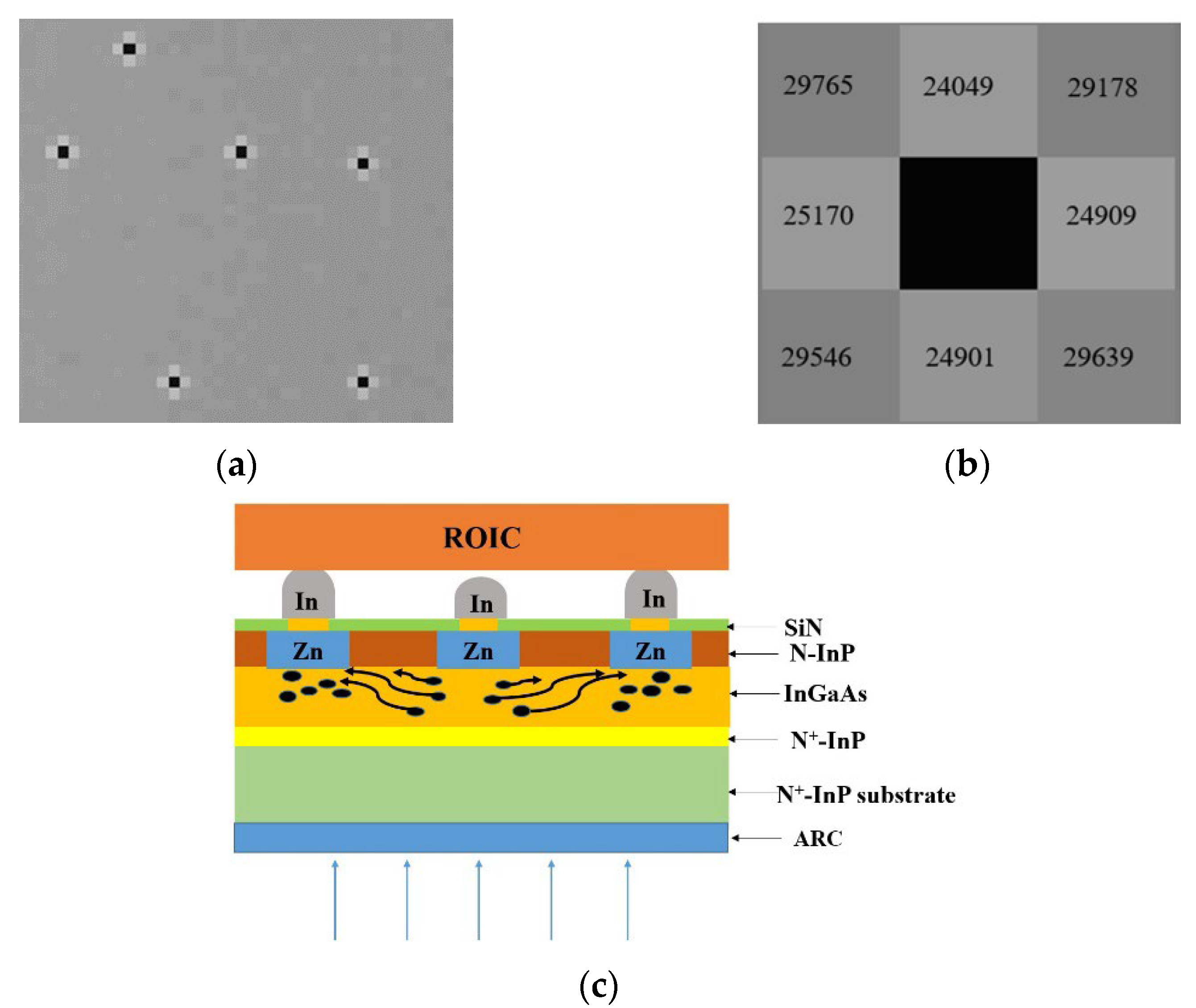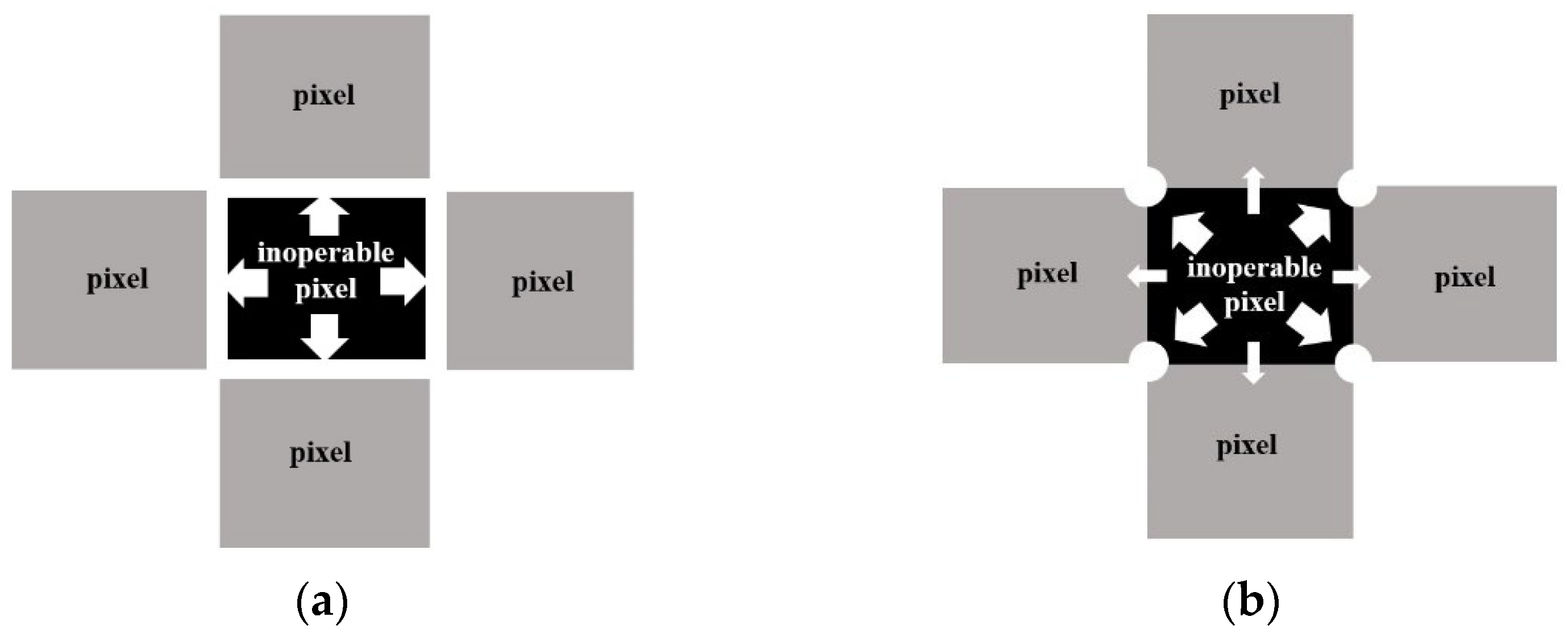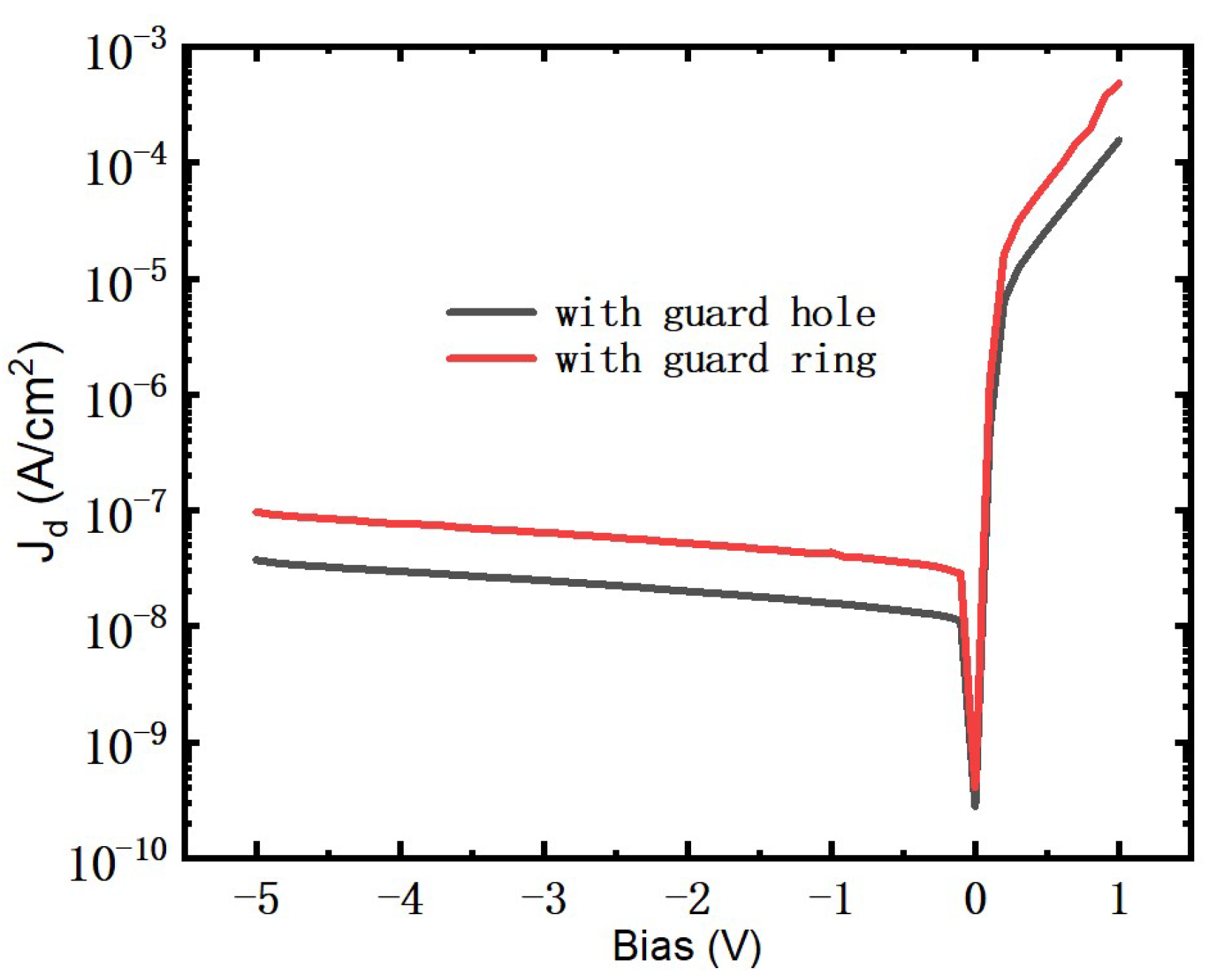Suppression of the Electrical Crosstalk of Planar-Type High-Density InGaAs Detectors with a Guard Hole
Abstract
:1. Introduction
2. Fabrication of FPAs
3. Results and Discussion
3.1. Electrical Crosstalk
3.2. Dark Current Density
3.3. Quantum Efficiency (QE)
3.4. Detectivity D*
4. Conclusions
Author Contributions
Funding
Data Availability Statement
Conflicts of Interest
References
- Jun-hua, L.; Xin-Jiang, G.; Xun, Z. Technical progress of short wave infrared InGaAs focal plane detector. Semicond. Optoelectron. 2015, 36, 10–15. [Google Scholar]
- Xue, L.; Xiu-Mei, S.; Tao, L.; Jifeng, C.; Zhangcheng, H.; Songlei, H. Research progress of short wave infrared InGaAs focal plane detectors. Infrared Laser Eng. 2020, 49, 64–71. [Google Scholar]
- Seshadri, S.; Cole, D.M.; Hancock, B.R.; Smith, R.M. Mapping electrical crosstalk in pixelated sensor arrays. High Energy Opt. Infrared Detect. Astron. III 2008, 7021, 54–64. [Google Scholar]
- Zhu, Y.M.; Li, X.; Wei, J.; Li, J.W.; Gong, H.M. Analysis of cross talk in high density mesa linear InGaAs detector arrays using tiny light dot. Proc. SPIE 2012, 8419, 260–264. [Google Scholar]
- Zhang, K.L.; Wu, X.L.; Tang, H.J.; Qiao, H.; Jia, J.; Li, X.; Gong, H.M. Crosstalk and photoactive area of InGaAs linear de-tector by LBIC technique. Infrared Laser Eng. 2007, 36, 947–950. [Google Scholar]
- Yongfu, L.; Hengjing, T.; Tao, L.; Yaoming, Z.; Peilu, J.; Hui, Q.; Xue, L.; Haimei, G. Study on suppression of extension of photo-sensitive area for planar-type front-illuminated InGaAs detector by LBIC technique. J. Semicond. 2010, 31, 013002. [Google Scholar] [CrossRef]
- Lange, M.J. Successful detector design is a game of give and take. Photon. Spectra 2005, 39, 70–77. [Google Scholar]
- Estribeau, M.; Magnan, P. Pixel Crosstalk and Correlation with Modulation Transfer Function of CMOS Image Sensor. Proc. SPIE Int. Soc. Opt. Eng. 2005, 5677, 98–108. [Google Scholar]
- Yong-fu, L.; Heng-jing, T.; Yao-ming, A.; Tao, L.; Hao, Y.; Tian-xin, L.; Xue, L.; Hai-mei, G. Application of AFM/SCM and LBIC technology in the design of InGaAs detector with planar protection ring structure. J. Infrared Millim. Wave 2010, 29, 401–405. [Google Scholar]
- Xiumei, S.; Tao, L.; Honghai, D.; Jifeng, C.; Yu, C.; Hengjing, T.; Xue, L. Planar 24 element InGaAs short wave infrared detector. Infrared Technol. 2011, 33, 501–504. [Google Scholar]
- Li, X.; Tang, H.; Li, T.; Fan, C.; Shao, X.; Li, J.; Wei, J.; Gong, H. Crosstalk study of near infrared InGaAs detectors. Infrared Technol. Appl. XLII 2016, 9819, 630–636. [Google Scholar]





| Parameter | R | Ra | |Rf − Ra| | C |
|---|---|---|---|---|
| Guard ring | 27,800 | 27,919 | 119 | 0.40% |
| Guard hole | 27,299 | 28,724 | 1425 | 4.5% |
| Parameter | Apn /μm2 | Jd /nA/cm2 |
|---|---|---|
| Guard ring | 84.26 | 28.5 |
| Guard hole | 35.33 | 11.2 |
| Ratio of guard ring to guard hole | 2.38 | 2.52 |
| Parameters | Rv v/w | Vn v | D* cm·Hz1/2/w |
|---|---|---|---|
| Guard hole | 5.89 × 1011 | 2.42 × 10−3 | 2.89 × 1012 |
| Guard ring | 3.56 × 1011 | 3.46 × 10−3 | 1.22 × 1012 |
| Ratio of guard ring to guard hole | 1.65 | 0.7 | 2.37 |
Publisher’s Note: MDPI stays neutral with regard to jurisdictional claims in published maps and institutional affiliations. |
© 2022 by the authors. Licensee MDPI, Basel, Switzerland. This article is an open access article distributed under the terms and conditions of the Creative Commons Attribution (CC BY) license (https://creativecommons.org/licenses/by/4.0/).
Share and Cite
Zhang, J.; Wang, W.; Ye, H.; Huang, R.; Hou, Z.; Liu, C.; Zhao, W.; Li, Y.; Ma, X.; Shi, Y. Suppression of the Electrical Crosstalk of Planar-Type High-Density InGaAs Detectors with a Guard Hole. Micromachines 2022, 13, 1797. https://doi.org/10.3390/mi13101797
Zhang J, Wang W, Ye H, Huang R, Hou Z, Liu C, Zhao W, Li Y, Ma X, Shi Y. Suppression of the Electrical Crosstalk of Planar-Type High-Density InGaAs Detectors with a Guard Hole. Micromachines. 2022; 13(10):1797. https://doi.org/10.3390/mi13101797
Chicago/Turabian StyleZhang, Jiaxin, Wei Wang, Haifeng Ye, Runyu Huang, Zepeng Hou, Chen Liu, Weilin Zhao, Yunxue Li, Xu Ma, and Yanli Shi. 2022. "Suppression of the Electrical Crosstalk of Planar-Type High-Density InGaAs Detectors with a Guard Hole" Micromachines 13, no. 10: 1797. https://doi.org/10.3390/mi13101797
APA StyleZhang, J., Wang, W., Ye, H., Huang, R., Hou, Z., Liu, C., Zhao, W., Li, Y., Ma, X., & Shi, Y. (2022). Suppression of the Electrical Crosstalk of Planar-Type High-Density InGaAs Detectors with a Guard Hole. Micromachines, 13(10), 1797. https://doi.org/10.3390/mi13101797





